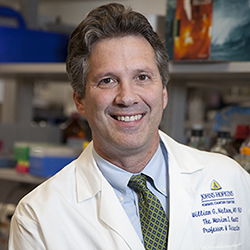Exploring the Role of Metabolism in Cancer
Guest Post by William G. Nelson, MD, PhD
Editor-in-Chief, Cancer Today
Cancer cells ingest copious amounts of the simple sugar glucose. This addiction may hold the key to how cancer can be treated.
All cancers start as a single rogue cell that begins to reproduce itself uncontrollably. One cancer cell becomes two, two become four, four become eight and so forth until a billion or more have appeared, often in the form of a tumor that can be felt or detected through radiographic imaging. Cancer cell replication, if unchecked, often leads to invasion of normal organs and metastasis to remote sites in the body, threatening life.
To fashion two cancer cells from one, every cell component—DNA, RNA, protein, fat, and carbohydrates—needs to be duplicated. A living human cell needs at least 6 billion DNA base-pairs, billions of protein molecules, and enough fat molecules to form an enveloping membrane.
Fabrication of a new cancer cell also requires energy. In the human body, normal cells obtain the energy needed for building cell components by metabolizing glucose and producing “fuel,” adenosine triphosphate (ATP). When oxygen is readily available, glucose is metabolized to produce pyruvate, which is delivered to the mitochondrion, the cell’s “engine room,” where ATP is created. In the absence of oxygen, glucose tends to be metabolized to lactate, with a low yield of ATP.
In 1924, Otto H. Warburg, a German physician-scientist later awarded the Nobel Prize for Physiology or Medicine, recognized that cancer cells metabolized glucose to lactate despite the presence of oxygen—a phenomenon called the Warburg effect. A mystery remained: If cancer cells need prodigious amounts of energy to build billions of progeny, why do they use a low-efficiency strategy for producing ATP?
Researchers Matthew Vander Heiden, Lewis Cantley, and Craig Thompson believe they may have an answer. They argue that normal cells use high- or low-efficiency means to produce ATP depending on whether the cells are pursuing specialized functions or undergoing replication, even when ample oxygen is present. The high-efficiency approach to ATP generation is favored most of the time. But when new cells are needed, the low-efficiency approach of producing ATP by metabolizing glucose to lactate is favored to produce energy as well as the building blocks for new cell components. The relative inefficiency is offset by augmenting the supply chain for building cell components.
As Warburg recognized, cancer cells adopt the low-efficiency approach to ATP generation. In this way, they resemble proliferating normal cells, ravenously consuming glucose in order to produce progeny.
Can cancer’s dependence on the inefficient metabolism of glucose to lactate be targeted to treat the disease? Obesity and high blood levels of insulin, insulin-like growth factors, and glucose have been linked to the development of many types of cancer and to poor cancer outcomes generally. On the other hand, metformin, a drug used to manage diabetes, may benefit some people with cancer. As cancer cell metabolism is better comprehended, a new wave of anti-cancer drug discovery aimed at cancer cell metabolism is coming. The key will be finding which drugs selectively interfere with cancer cell metabolism, but not the metabolism used by normal cells to proliferate.
Cancer metabolism has intrigued cancer researchers for nearly a century. The growing understanding of how cancers use metabolism to grow from a single cell to billions of cells is finally leading to improvements in cancer detection, diagnosis, prevention, and treatment.
William G. Nelson, MD, PhD, is the editor-in-chief of Cancer Today, the quarterly magazine for cancer patients, survivors, and caregivers published by the American Association for Cancer Research. Nelson is the Marion I. Knott professor of oncology and director of the Sidney Kimmel Comprehensive Cancer Center at Johns Hopkins in Baltimore. You can read his complete column in the fall 2017 issue of Cancer Today.




